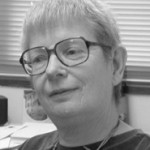
It is a great privilege and honor to introduce Alexandra Navrotsky as the recipient of the 2006 Harry H. Hess Medal. She is an outstanding scientist who has made important contributions to our understanding of minerals and other materials through a wide range of theoretical and experimental applications of thermodynamics. She was trained as a physical chemist and originally approached oxide chemistry through a materials perspective. However, her interests broadened and she became known as a leading authority in a wide range of subjects from chemistry through materials science to the geosciences. She held faculty positions at Arizona State University (Tempe) and Princeton University (N.J.) and is now at the University of California, Davis.
Alex has always impressed us by her depth of understanding of mineral chemistry, and we think she is the world’s leading scientist in the field of thermochemistry of minerals and related solid-state materials. At conferences she always has something important to say and in many instances demonstrates the ability to ask questions that go right to the heart of the matter being discussed.
Alex is recognized as a world leader in the geoscience community. She has trained a generation of students and postdoctoral fellows, scientists who now lead geoscience programs as faculty members in universities worldwide. Beginning with her early years in academia, she organized numerous workshops, conferences, symposia, and short courses that broke new ground in understanding the energetics, structures, and bonding in minerals and related materials. Her efforts at Arizona State and Princeton were instrumental in opening up the field of mineral physics, and she helped to spearhead the effort that eventually led to the creation of the Center for High Pressure Research—located at the State University of New York at Stony Brook, the Carnegie Institution of Washington, and Princeton University—the U.S. National Science Foundation Science and Technology Center, where for 11 years she not only served as a coprincipal investigator but also was one of its most effective spokespersons. During this time, she was elected to the U.S. National Academy of Sciences and was the first woman faculty member to be so elected from Princeton University.
While continuing to contribute to high-pressure geoscience, in the pastseveral years Alex has focused her attention on nanomaterials, microporous, and other complex materials of the near-surface environment. This effort includes studies at the bio-geo interface. While maintaining a foothold in thermochemistry, she continues to lead teams and collaborate with scientists utilizing whatever complementary techniques are necessary to understand materials phenomena, including neutron scattering, synchrotron radiation, vibrational spectroscopy, and ab initio calculations. This effort has been facilitated by her latest Center creation, Nanomaterials in the Environment, Agriculture, and Technology (NEAT), a unique and well-funded new enterprise that spans the physical and biological sciences.
In conclusion, with over 500 published papers covering order-disorder phenomena, glasses and melts, perovskites and oxides, and nanomaterials and microporous materials, it is difficult to find a person having a greater impact in the mineral sciences. Therefore we are very pleased that our longtime friend and colleague, Alexandra Navrotsky, is to receive the 2006 Harry H. Hess Medal of the American Geophysical Union.
—CHARLES T. PREWITT and ROBERT C. LIEBERMANN, University of Arizona, Tucson; and Stony Brook University, Stony Brook, N.Y.


